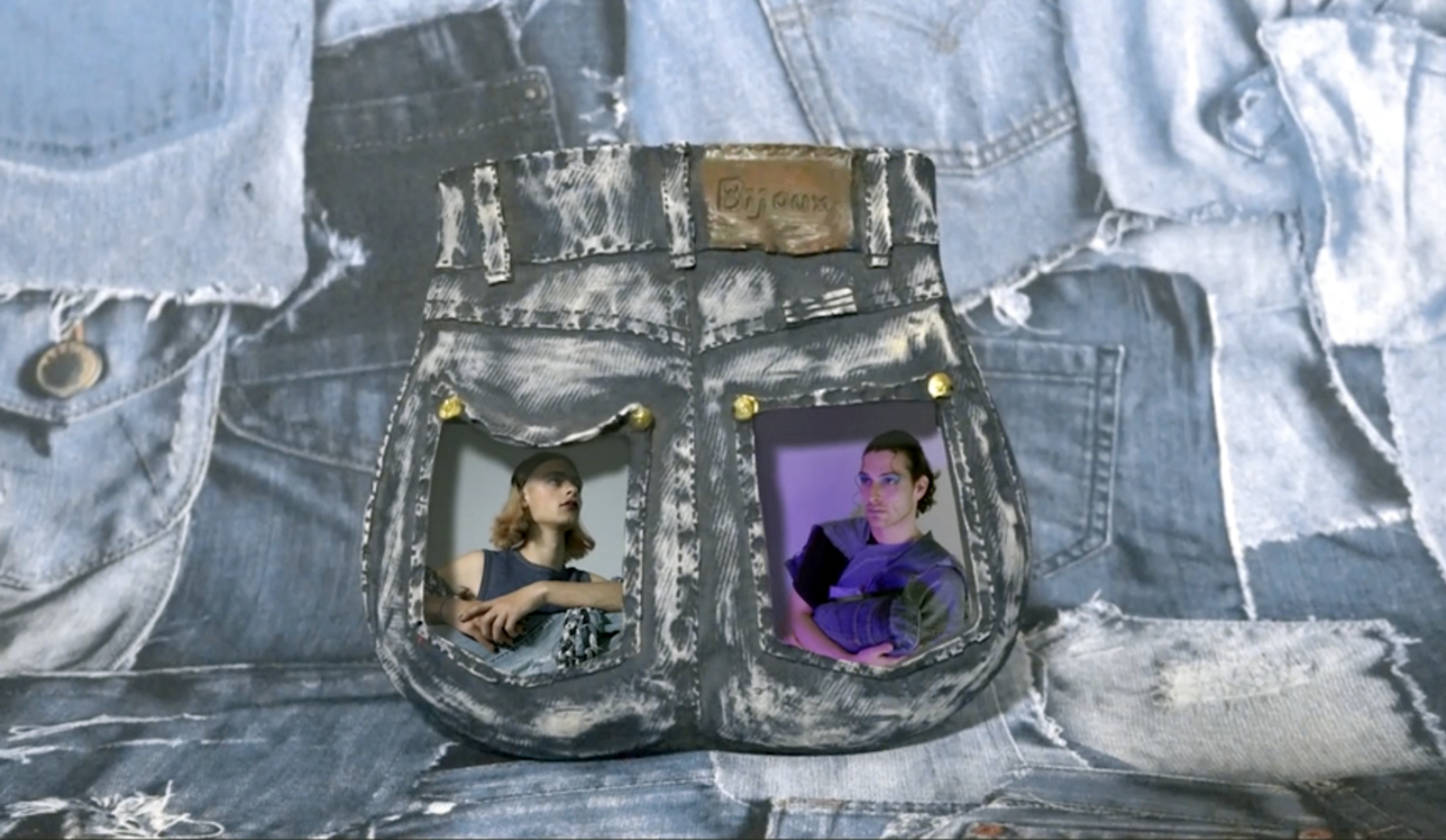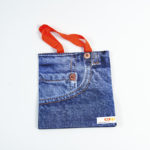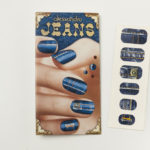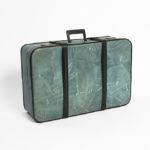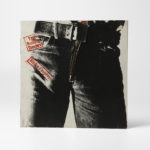Jeansdinge : chronique d’une collection en mouvement
Bienvenue à Jeansdinge.com - le site web est en ligne
Résumé
Jeansdinge était à l’origine, au début des années 2000, une collection d’objets en denim, que les artistes et chercheuses Katharina Hohmann et Katharina Tietze ont réunis pour une exposition dans un ancien kiosque est-allemand à Weimar, ville du Bauhaus, où elles exploraient les zones grises entre l’art et la mode. Les questions esthétiques et politiques soulevées par ces artefacts de la pop culture américaine ont conduit Katharina Hohmann à diriger le projet de recherche Jeansdinge on the Move entre 2021 et 2022. Dans cet article en forme de chronique, elle détaille les multiples approches artistiques et critiques développées autour de la collection. Toutes ces productions sont à retrouver sur le site : jeansdinge.com
Texte
Jeansdinge: the Challenges of Proliferation
For 18 months spanning 2021 and 2022, the usually hushed premises of the IRAD (HEAD’s Institute for Research in Art and Design) were gradually invaded by all sorts of gaudy objects. As an office neighbour, I observed with amusement the secret conciliations held by researchers amidst piles of mugs, sandals, key rings, rugs, umbrellas and trinkets in blue – and sometimes fake or even printed – denim of dubious taste. A work of art in itself, this quirky pop collection of some 500 items had been dormant for several years. Initiated and led by Katharina Hohmann, the research project, lying somewhere between art and fashion, had the aim of activating, exhibiting and analysing that collection.
Launched in December 2022, the Jeansdinge website now brings together all the outcomes of this research project – including detailed descriptions for each object, essays, artists’ videos, and exhibition documentation. Through the medium of art and criticism, some answers are provided to the question underpinning the collection: how has denim become so ubiquitous? Ubiquitous to the point that it not only dresses the majority of the world’s population, but is also used in heterogeneous objects with no connection whatsoever to fashion, in an apparent triumph of vulgarity. For the researchers, this process stems from the iconic status that jeans have attained as the standard of the dominant capitalist US culture. At the same time, by offering ease of movement, denim has promoted gender equality and, as the researchers point out, ‘was taken up by queer groups to overcome these oppositions, to transgenderise the style’ by associating with the LGBTQIA+ aesthetic.
Questioning the apparent paradox of a textile of standardisation on the one hand and its protean appropriation on the other, as well as the cultural issues raised by vulgar objects in the field of design, Jeansdinge multiples the angles to offer a kaleidoscopic vision on denim.
Katharina Hohmann describes in the following chronicle the different forms it has taken and the interpretations of the objects by the artists who have used them.
Sylvain Menétrey
Jeansdinge Moving On
It all started in the early 2000s – when the world was not (or did not seem) as troubled as it is today. I remember those years as being, in a way, very inventive and marked by a spirit of optimism. Katharina and I met in Weimar, a small, historically charged place where in former times, writers and philosophers tended to meet and sit in the wonderful Park an der Ilm. The German Wende had taken place almost ten years previously, and this little town was full of hope for a future where things could be reinvented and developed further in a united Germany.

In Weimar, we found a small GDR kiosk built in 1968 as a serial post-office modular unit, under a huge maple tree. Only a few have survived the turbulent times after reunification. Most of these beautiful kiosks made of anodized aluminum and glass have been demolished.
I first met Katharina Tietze in the so-called Saloon. I received an invitation designed in an American Western-like cowboyish look – fake wood if I remember correctly – on one side, in big letters SALOON, and on the other, the date and the place. I went to the meeting, which took place in a room with a fireplace, entirely wood-paneled, Bauhausian lounge furniture and indirect light. Katharina and Sabrina, both in their thirties, had been inviting a small circle of women from the Weimar cultural scene, and created a series of theme-oriented meetings dealing with women’s issues, which lasted a couple of years. Katharina, one of the hosts, and I were the only two working at Bauhaus Universität Weimar at that time – I was in the Gestaltung-Department in Visual Arts and Katharina in the Media Department in Fashion and Public Apparitions, which I always thought was a wonderful title to de-limit the topic of fashion in a university context.
We called our Kiosk, K&K. Zentrum für Kunst und Mode – and we showed almost 70 exhibitions where art and fashion overlapped. Their frontiers were in fact blurred and pop culture, clothing and their social and political dimensions were given serious consideration. By curating this small 24/7 vitrine for several years, we gradually slipped into the role of researchers exploring that yet-to-be-widely discussed grey zone where art and fashion meet. Each show was accompanied by a text, commissioned from authors with different backgrounds, or written by ourselves.
At the end of the project in 2006 we were editing a magazine and slipped a hundred copies into the revolving newspaper racks, which were part of the kiosk’s original furniture.


The 14th exhibition, which opened on Sunday, November 3rd, 2002, was dedicated to the Jeansdinge archive in the making. We had invented this word: a neologism made of Jeans and Dinge. It was the public beginning of a collection, which, as far as we know, is the only one of its kind.
The Jeansdinge, as well as other objects- and archive- or inventory-oriented exhibitions we were showing in the GDR kiosk, resonated with the Bauhaus and the traces of its visionary elegance that surrounded us. As we were about to leave the 20th century, I believe our concerns and practices can be read with the Bauhaus as their background. Indeed, the fact that two (and more) different perspectives were collaborating on these projects spoke to the Bauhaus’ legacy.
Almost all the Jeansdinge objects were mass-produced, while the objects shown in the Bauhaus Museum in Weimar, 300 meters away from the K&K kiosk, were handmade prototypes. In the Bauhausian objects, the charm of their invention permeated each of them. The make and materials of these objects – including many textiles – were quite the opposite of the accessories and object collections we showed at the kiosk: discarded purses, textile handkerchiefs, one-piece swimsuits from the GDR or even clothes hangers. Trash, in comparison. Poor, cheap and vulgar. But cute and lovely. Or ugly. Even petty, irrelevant. All in one.
The Jeansdinge collection grew exponentially after this first exhibition, which contained only 40 items. Twenty years later, the collection amounts to 450 objects.
In 2010, we brought it from Weimar to Zürich and stored it in grey plastic boxes. We were working on a book Denimpop. Jeansdinge Lesen, with the Berlin-based Merve Verlag. We wanted to put the questions that arose in connection with the objects in the collection to authors from different disciplines. Exhibitions followed in Switzerland, and we had a beautiful and very well-attended book launch at Museum der Dinge, Berlin, in 2014. The book appeared in all the bookshops we liked. This was a first step. The small pathetic things had now entered the space of knowledge and art, design, and media theory.

But in a way, the seemingly sleeping objects have rumbled in their grey boxes ever since. For the past two years, we have removed them from their boxes and have made them into the focus of a collective research process. Our friend Manuel Fabritz took studio photos of every item. And together with researcher and fashion theorist Aude Fellay, researcher Loreleï Regamey and artist Chaïm Vischel, we began to ask ourselves what could be made of this collection, what it amounted to, and how we were to deal with these cheap, mass-produced, and un-authored objects in the context of art and design today.
Right at the beginning of the 18-months- research-period, together with our colleagues, we were travelling to several institutions in Switzerland to study how fashion and textile collections were (also) dealing with Jeans and denim, and to discuss issues of archiving and storing, or how to build up an inventory, or a data bank. But of course, we also tried to think about the role of our, somehow cheap and hybrid, Jeansdinge collection in comparison with already existing historical collections: Le Musée Suisse de la Mode in Yverdon-les-Bains, the Textilmuseum and the research project TaDa (Textile and Design Alliance), both situated in Sankt Gallen, and the biggest design collection in Switzerland, which is part of the Museum für Gestaltung situated in Zürich. At the Toni Areal (where the ZHdK also has its main venue), we were able to visit this huge collection in the underground depot. One quite unique and weird collection dealing with Jeans is situated on the fourth floor of a residential building in Zürich. Held by a private person, it includes thousands of Jeans from their invention and brevetting in 1873 by the Bavarian Levy Strauss and the Californian Jacob Davis – till today. The item is only ‘valuable’, according to the collector, if the trousers have (almost) never been washed – this means the folds and wrinkles are most visible, as human sweat functions like a liquid imprint fluid.
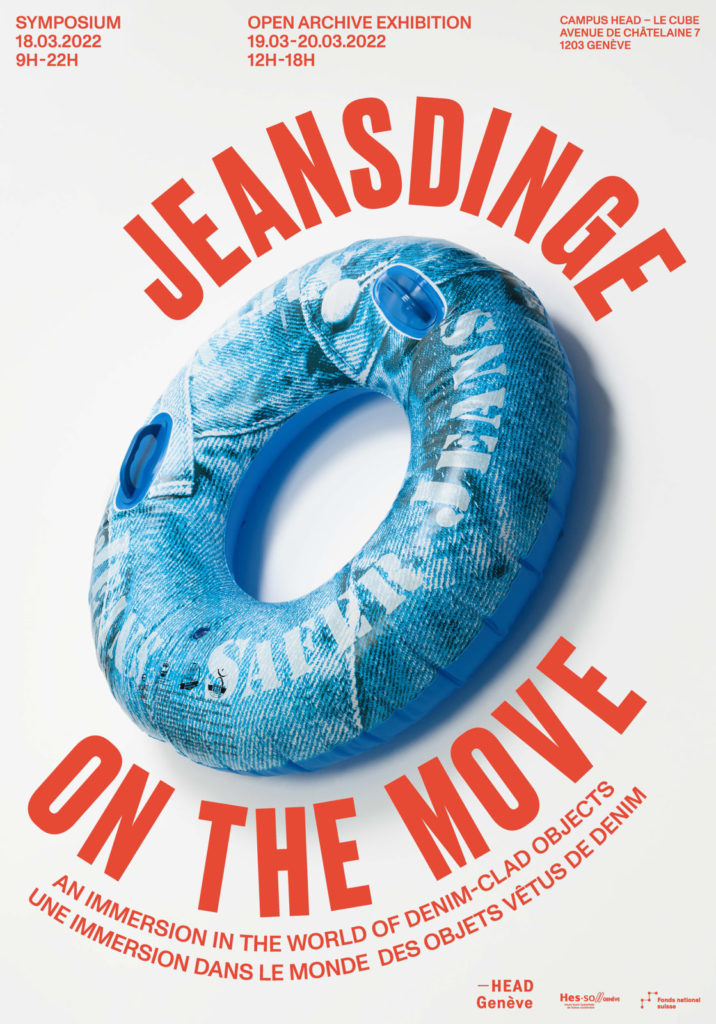
From the beginning of our research period, we were set on using the public symposium format as an arena to voice our questions and share them with the public and specialists. It was held on March 18th, 2022. For Jeansdinge on the Move, the objects were organized and presented in five hubs, thematically arranged installations, in the vast space of the Cube at HEAD – Genève. Now our items were the protagonists; they were, in a way, meant to speak, to become actors through the voices and thoughts of invited artists, designers, museum curators, researchers, authors, theorists, filmmakers, and performers.

For one day, the public moved through the space, changing seats, and reorganizing themselves around each thematic installation, following the topics and speakers. Moving for more than ten hours till, at eight pm, the dance floor opened with a sound mix composed of songs from the collection’s CDs.
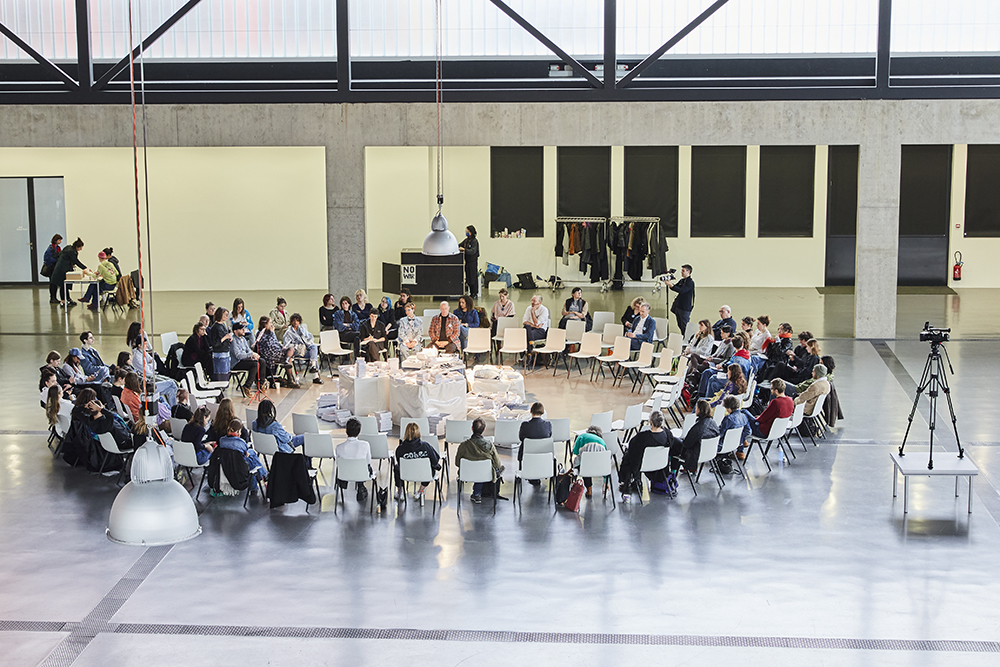
The open archive was made available to the public:

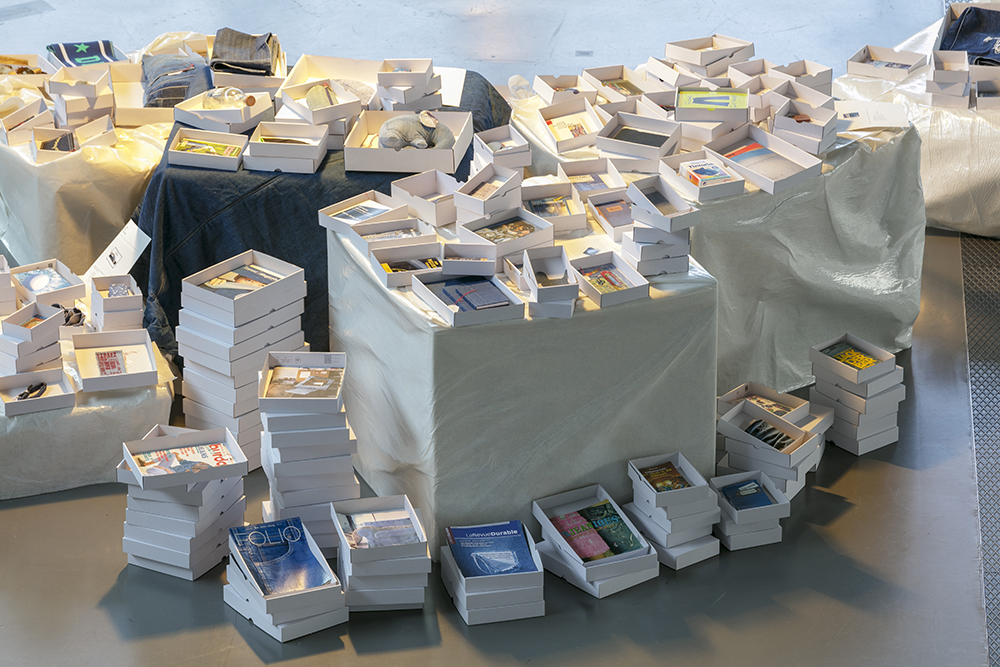
Some months later, artists, designers, as well as design-students from the ZHdK (Katharina Tietze heads the Trends and Identity department at ZHdK) and art students from HEAD – Genève produced a bunch of different short films, including one or two objects from the collection. The fact that collected items in general – in archives, museums, private collections – remain in storage and are therefore inaccessible has been one of the driving forces behind our decision to return the Jeansdinge to life. The objects became actors equipped with gestures, and maybe voices, in, at times, surreal and fictional cinematic plots. These experiments can now be viewed on the collection’s dedicated website, where you can browse through almost 40 movies. The ongoing film collection was supervised by filmmaker Lucien Monot. And the films were shown in December 2022 at Centre d’art Contemporain in Geneva.
The construction of Lucien Monot’s photo-novel Denim Suspect is reminiscent of Chris Marker’s La Jetée. It collages audio from a police exchange about the tailing of a suspect wearing size 44-45 denim, and photographs taken in Geneva with a 24-shot disposable camera – an iconic object from the collection clad in fake denim. The film is testament to the seamless transposition of American culture into our everyday lives.
For Lol, Philomène Lacroix embedded a bottle of Versace’s Red Denim perfume in found footage shot in that hotspot for physical culture, show-off and American kitsch – Venice Beach. In this appropriate setting, a hand with oversized fingernails humourously sprays the perfume under the armpits of bodybuilders.
Our brand-new website, www.jeansdinge.com is now on view thanks to designers Rob van Leijsen, Sonia Dominguez and Nico Baldran. The website assembles and shows all the items in the collection and gives access to the vast and various content the collection has generated: text, images, videos from the symposium, the films, as well as a soundtrack, composed especially for the website.
One by one, every object has been given a stage: an image and an archive entry with the description of the items’ properties, their provenance, year of production and entry into the collection, donor initials and – if possible – the country of production. The collection has grown since: another 40 objects have entered the collection since the symposium, and they are not listed yet!
With the help of object categories, you can now also choose and reassemble families of items and look at them together.
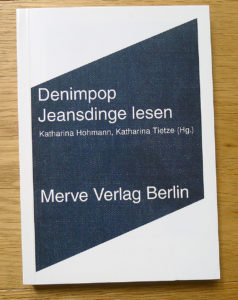
Our book Denimpop. Jeansdinge lesen (2013, MERVE Verlag, Berlin) has been translated in full. You can read the 18 articles in English in which authors from different fields interpret and analyze objects from the collection: media- and design theorists, a DJ, an archaeologist, a philosopher, artists, designers and art historians.
If you click the Rivet button on the website, you’ll find a list of contributors – the ever-expanding Jeansdinge-community – at the heart of the project. With their help, we have constructed this Jeansdinge summary – be they co-collectors, students, contributors, discussion partners, friends, or fans.
Let’s see what’s next.
Katharina Hohmann for the team: Aude Fellay, Katharina Tietze, Loreleï Regamey, Chaïm Vischel. March 2023
